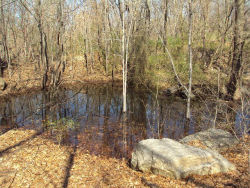Givans Creek Woods
Givans Creek Woods
Adjacent to Co-op City’s urban development, Givans Creek Woods is a natural area that not only preserves many plants and animals that once thrived here, but also reminds us of the families who settled this area over two hundred years ago. In 1795 Robert Givan, his wife Agnes Thompson, and their seven children, emigrated from Kelso, Scotland to what was then Westchester. They settled on a tract of land purchased from the Bartow family, chosen for its high elevation and a navigable creek that emptied into the Hutchinson River. Givan established a mill here which he powered with the tidal run of the creek which bore his name. He built his estate, named Edman after his home county in Great Britain, east of the present day Givan Square, at the intersection of Eastchester Road and East Gun Hill Road. Givan died in 1830, leaving his considerable estate to his descendants. They included members of the Palmer, LeRoy, and Morgan families, whose names are preserved in nearby streets. The property remained in the family until 1881, when it was divided into house lots for sale.
Much of this region remained undeveloped into the 1950s with the exception of a few farms. Though the Freedomland U.S.A. amusement park (in operation from 1960 to 1965) had a short life, it paved the way for the development of Co-op City, the massive housing complex that was built between 1968 and 1970. The desire to preserve remaining natural areas heightened in the 1980s and, after a seven-year effort by community activists and environmentalists, Givans Creek Woods was designated as passive parkland by Mayor Giuliani in 1995. At this time the Friends of Givans Creek Woods was formed to ensure citizen participation in the preservation of the natural area.
Though the creek itself is now covered by Co-op City, natural diversity endures in Givans Creek Woods, which is bounded by the New England Thruway and Tillotson Avenue on the west, Rombouts Avenue on the north, and Co-op City Boulevard on the south and east. Comprised of upland forests of oak and hickory, a low-lying wooded wetland, surrounding meadows, and rocky outcrops covered with mosses and lichens, it contains fragments of several original habitats otherwise lost on the west bank of the Hutchinson River. Among the more than 150 species of plants and 45 species of animals living in the park, several New York State protected plants have made their home, including Flowering Dogwood, Wild Pink, and native ferns.
Check out your park's Vital Signs
Clean & Safe
Green & Resilient
Empowered & Engaged Users
Share your feedback or learn more about how this park is part of a
Vital Park System


